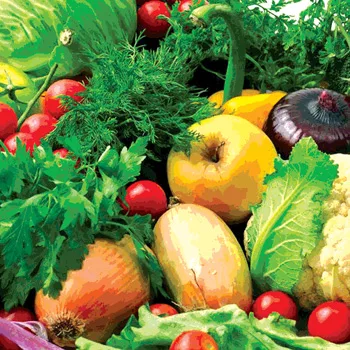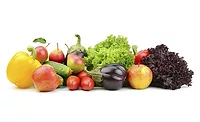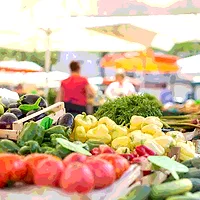Food Safety and Farmers Markets

Visiting with your neighbors, listening to live music while shopping, meeting the farmer who grew the produce, sampling the fresh food in the market, the festival-like atmos-phere…that is the downhome feel that has Americans flocking to farmers markets.
And with all of these eager customers, the number of farmers markets has increased by almost 370 percent since 1994, with over 8,100 farmers markets listed in the U.S. Department of Agriculture (USDA)’s market directory in 2013. The local food movement sweeping the country is inspired by initiatives such as USDA’s Know Your Farmer, Know Your Food, Farm to School and The People’s Garden, a collaborative effort of over 700 local and national organizations working together to establish community and school gardens across the nation to unite neighborhoods and inspire locally led solutions to hunger and environmental concerns. The interest is nowhere more evident than at farmers markets.
Who are the customers shopping at these markets? It takes only a trip on an early Saturday morning to see that many of the customers are senior adults, people who may have health problems and mothers with young children all shopping for foods they perceive to be healthier and safer than those you buy in the grocery store. This means that many of the customers may be in population groups most at risk for foodborne illness and the serious complications that can be associated with it. What is often casually observed is an attitude, not just among consumers but among farmers and market managers as well, that “It’s locally grown…I know that farmer…It’s organic…so it is healthier and safer than what I could get at the store.”
The Reality
Whether produce is from your own backyard or thousands of miles away, it can be contaminated if not handled properly. A recent study involving surveys of farmers on small farms and of market managers[1] found that there is room for improvement when it comes to food safety practices. The study found that 41 percent of farmers who responded to the surveys had been farming for only 3 years or less, and 61 percent of the market managers had only managed a market for only 3 years or less.
Although the farmers and market managers used many good practices, some practices being used may put consumers at risk for foodborne illness. These practices could increase the risk of produce contamination from land and water used in growing and washing produce from hygiene practices of workers handling produce, unsanitary conditions during on-farm handling and transportation of produce to market, and contamination in the market itself.
The surveys found that approximately 56 percent of the farmers who responded used manure for fertilizer. Of those, 34 percent used raw manure or mixtures of raw and composted manure. Various composting practices were indicated that may or may not be adequate to eliminate microbial pathogens. Approximately 26 percent of those using manure waited less than even the minimum 90 days between application and harvest recommended in the National Organic Program for crops that do not touch the soil. Over 50 percent of the farmers indicated that farm animals or domestic animals had access to their growing areas. Approximately 30 percent used water from sources not tested for safety to irrigate produce, and 16 percent used untested water for washing produce before taking it to market.
Almost 67 percent of the farmers provided handwashing and bathroom facilities for workers near the growing areas. Although this is a good percentage, it still needs to be better. Only about 41 percent had ever offered any kind of sanitation training for people harvesting or handling the crops, yet about 50 percent indicated that their crops are harvested with bare hands. Over 43 percent of farmers who responded did not use sanitizers on surfaces at their farms that come into contact with produce.
Market managers were asked a series of questions about practices in their markets. The survey found that over 40 percent of the 45 managers who responded indicated that they have no food safety standards in place for the market. Around 90 percent fail to ask questions of farmers or vendors that could help consumers avoid food from unsafe sources. These include questions related to the use of raw manure, exclusion of animals from growing areas, availability of handwashing and bathroom facilities for farm workers, use of sanitizers in packing sheds and other produce handling facilities, whether farmers offer sanitation training to workers handling the produce, etc.
Even in the marketplace, sanitation can be an issue. Less than 60 percent of market managers surveyed had handwashing facilities available for vendors and market workers. In addition, less than 25 percent sanitized surfaces at the market, and only 11 percent always cleaned containers used in the market between uses. Even though 67 percent of the managers allowed sampling in their markets, they offered no sanitation training to vendors related to safe handling of samples.
What Could Be Better?
If you took a tour of your local farmers market, what would you see? Many local markets are held in open fields in city parks or even in parking lots. Conditions may be less than sanitary. You are likely to observe fruits and vegetables displayed on the ground rather than being held at least six inches above this surface, as would be required in food storage areas of restaurants or grocery stores. You are also likely to encounter customers or even vendors bringing their dogs into the market area and having access to displays. You may or may not see handwashing facilities or at least hand sanitizer being provided in the market. Some of the produce may already be packaged in open bags for customers to pick up, or customers may be allowed to handle and select their own produce. You may even see stations where customers can bring produce they have just purchased to be juiced or blended into healthy shakes—with no evidence of facilities for washing produce, hands or equipment. You may see displays where customers can sample cut produce that is not being kept on ice or refrigerated. You may also see entrepreneurs who are making and selling food products that you hope are at least following cottage food regulations. As a food safety professional, you see opportunities for increased risk of foodborne illness.
With the prevalence of obesity in the U.S. and the increased emphasis on fresh fruits and vegetables as an essential part of a healthy diet, farmers markets and the local food movement offer great opportunities for access to fresh fruits and vegetables in food deserts and areas where consumers may have limited access to fresh produce. Local markets can also increase the economic viability of small farms and the communities they serve. However, this increased emphasis on local foods may also mean an increase in the number of people growing and handling fresh produce with limited experience in farming and best practices for ensuring the safety of the products they are growing. Potential foodborne illness outbreaks traced to local markets could threaten the success of the local food movement.
How Do We Enhance Safety?
As part of a USDA-National Institute of Food and Agriculture multistate grant-funded initiative by the University of Georgia, Virginia Tech and Clemson University, two curriculum packages for training farmers on small farms and farmers market managers have been developed. Extension agents in these states have been trained to deliver and evaluate educational programs for these audiences. The objective of these educational efforts is to enhance the safety of locally grown produce, to reduce liability risks to farmers and market managers, to help reduce risk of foodborne illnesses for consumers and thus help ensure the economic viability of local markets. For more information about the program, contact Judy Harrison, Ph.D., University of Georgia, at judyh@uga.edu.
Judy A. Harrison, Ph.D., is a professor and Extension foods specialist in the department of foods and nutrition at the University of Georgia.
Reference
1. Harrison, J.A. et al. 2013. Survey of food safety practices on small to medium-sized farms and in farmers markets. J Food Prot 76(11):1989–19s93.
Looking for quick answers on food safety topics?
Try Ask FSM, our new smart AI search tool.
Ask FSM →








